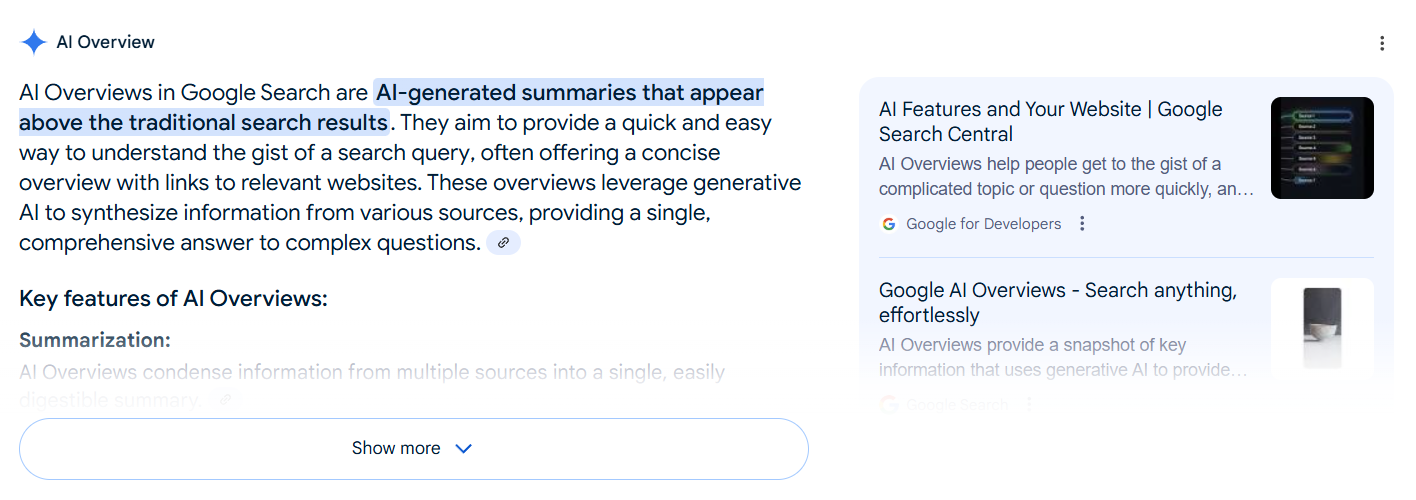
What was your first reaction when you saw Google’s AI Overviews? Since the rollout, many content creators have voiced concern, confusion, and more than a little anxiety. Sounds familiar? That’s why we did AI Overviews research for you, so you can catch your breath! In this article, we’ll explain what exactly AI Overviews are, why they’re making headlines (and causing headaches), and what they could mean for your website visibility. And if you’re already wondering how to rank in AI Overviews, stay tuned, we’ll cover that in a separate article, which is coming soon.

What are AI Overviews
Featured snippets have been a part of the search landscape for years, providing quick answers directly pulled from a single web page. Now, AI Overviews, while still relatively new, appear in the same prominent position at the top of search results, but please don’t be fooled by their familiar placement. AI Overviews are created by generative artificial intelligence and are made to provide more in-depth, conversational responses. An AI Overview typically includes a direct answer to the user’s question, a list of helpful links for further reading, and a disclaimer noting that the feature may generate incorrect or misleading results. What’s interesting is that you will most likely not see AI summaries for searches where people are clearly looking to buy something or are searching for a specific internet address. Here, you can see an example of a Google AI-generated response:

The global reach of AI Overviews
Google has rolled out AI Overviews gradually and selectively. Instead of a worldwide launch, the feature was introduced in phases, beginning with the United States. It has since expanded to various other regions, such as Poland. As of May 2025, this feature is available in over 200 countries! Since the rollout, the number of AI Overviews answers has been rising. As per Semrush and Datos, Google AI-generated summaries were appearing in 13.14% of the desktop searches in America in March 2025, which is a 102% jump since January of the same year.
AI Overviews tracker
There are several ways to monitor whether your website has been featured in AI-generated summaries. Here they are:
- One way to find out whether your site has been highlighted is by checking it manually:
- the first step is opening a new tab in incognito mode,
- next, you have to manually enter queries that you suspect might appear in AI summaries,
- check the results and start over!
- Another option is to go for an automated tracking solution like Keyword.com or Semrush, with which you can add keywords you want to track to check whether you got lucky.
Pros of AI Overviews for publishers
- You can think of AI summaries in Google as a new channel for displaying expert-level content. These can be your chance to gain visibility and stand out in a competitive space;
- Those users who are eager to know more about a particular subject will not be satisfied with a few-sentence summary and will most likely look for more in-depth information, and that is your chance to shine;
- Unfortunately, at some point, the internet was flooded with screenshots of absurd AI-generated answers, and although some of them turned out to be fake, the problem is real. Some industry specialists even state that inaccurate answers lead to growing skepticism toward the world’s top search engine. However, as trust in AI-generated content declines, publishers that produce reliable and expert content have a unique chance to reclaim their status as a trusted source. On the other hand, it’s worth remembering that AI gets better and better each day.
Cons of AI Overviews for publishers
- Some studies report that AI Overviews favor large news organizations, such as CNN or The New York Times. Unfortunately, this leads to limited exposure for smaller entities. The cause of this situation might be Google’s belief that bigger news organizations are more trustworthy;
- What’s vital is that since new AI summaries emerged, some publishers have reported a sharp drop in organic click-through rates (CTR), in some cases ranging from 30% to 45%. The underlying reason for this might be that answers are displayed directly in the search results. However, a fascinating fact is that when featured snippets were still a novelty, studies also indicated their destructive influence on CTRs. Over time, though, featured snippets became a standard part of the Google search experience;
- Google may include links to sources, but it’s not always evident which exact information in the summary is drawn from which site. Sadly, this approach frequently prevents publishers from getting proper credit for their work.
From panic to potential
Yes, AI Overviews are changing the game, but change doesn’t always have to be a threat. For publishers, this shift may present itself as both a challenge and an opportunity to adapt and remain at the forefront of the industry. Of course, as we all know, we live in unpredictable times, and it’s worth constantly improving the quality of your content to be able to stay in the game, but also participate in shaping the future era of digital storytelling! To gain more valuable knowledge on how to create great content, please don’t stop here and discover more publisher-friendly articles on our blog.


